Learn how to make Fermented Hot Sauce-a simple way to enhance and preserve your abundance of garden chilies to use throughout winter. Full of healthy probiotics, this easy recipe has many health benefits. Plus, it just tastes good! Video.
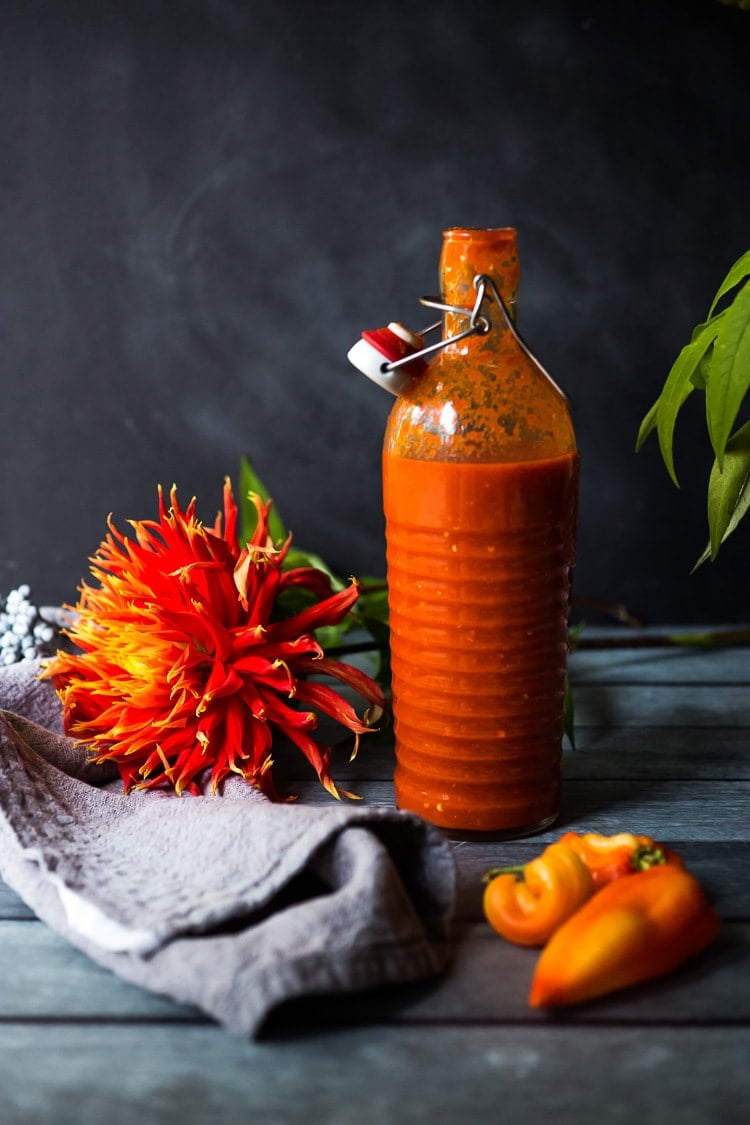
Why You’ll Love Fermented Hot Sauce
Here is my all-time favorite hot sauce recipe. As a chef, I’ve always loved making things completely from scratch-sauces, breads, condiments, you name it. Fermentation adds a layer of flavor that is so delicious and nuanced, and is much easier than you think!
Every year, when my chili plants overflow, I make this fermented hot sauce to preserve that harvest and keep the garden’s flavor alive all winter long. I’ve shared many fermentation recipes on the blog, and this hot sauce is easily one of the most approachable and rewarding ferments to start with.
Now, before you feel intimidated, know that this only takes 20 minutes of actual hands-on time and no special equipment. If you’ve ever wanted to try fermenting at home, this is the perfect beginner recipe!
Why I prefer fermenting over canning
- Healthier: Fermentation creates “ALIVE” food, incredibly rich in probiotics. These good bacteria are living creatures that work with our microbiome to improve digestion, boost immunity, and prevent disease. Having a diverse microbiome is healthy! Canning “kills” all these healthy probiotics through the heating process.
- Taste: I prefer fermentation over “canning” because fermentation keeps these healthy bacteria alive, and as a result, the fermented food actually tastes better and better with time! Canning halts the development of flavor.
- It’s easier: Canning requires more hands-on time.
Ingredients
- Fresh Chilies: medium heat chili peppers, such as red jalapeno peppers or red Padrón peppers. Feel free to add bell peppers in similar colors to make the hot sauce milder. Or use Green jalapenos or serranos and make a green hot sauce. If using habanero chilies, mellow them with orange or yellow bell peppers.
- Carrots: Add a sweetness and help with fermentation.
- Shallots or Onion, and Garlic: Add savory depth and complexity.
- Saltwater brine: You’ll need 1 1/4 teaspoons of salt per cup of warm water, or 3 grams of salt per 100 grams of water. Use filtered water and finely ground sea salt or pink Himalayan salt.
Variations
After fermenting, add optional seasonings to taste. Keep in mind, the “heat” will mellow with age.
- Herbs: oregano, cilantro, celery leaves
- Spices: cumin, coriander, chipotle powder, smoked paprika, allspice
- Vinegar: 1-3 tablespoons apple cider vinegar for extra tang and healthy probiotics
- Sugar: honey or sugar to taste-especially good if making sriracha
- For extra heat: cayenne or ground chipotle to taste
Salt Ratio for Fermenting Chilies
Having the right proportion of salt to water is important. Not enough salt may allow unhealthy bacteria to grow. Too much salt will kill all the bacteria, and the chilies won’t ferment. If you need to add more water to the jar, then add salt accordingly.
- Use 1 1/4 teaspoons fine sea salt per 1 cup of water. This is roughly a 3% brine (3 grams of salt per 100g of water).
- Here, I used 5 cups of water, so I added 1 1/4 teaspoons salt x 5 cups water = roughly 6 1/4 teaspoons of fine ground sea salt. Heating the water slightly helps the salt dissolve.
How to make Fermented Hot Sauce:
1. Fill a clean jar with veggies. Fill a clean 2-quart jar with any type of fresh hot chili, onions, garlic, and thinly sliced carrots. You can use bell peppers to temper the hot chilis if you want a milder version. Just stick with the same color palette so your fermented hot sauce stays colorful and vibrant. Here I am using red padron peppers with one red bell pepper.
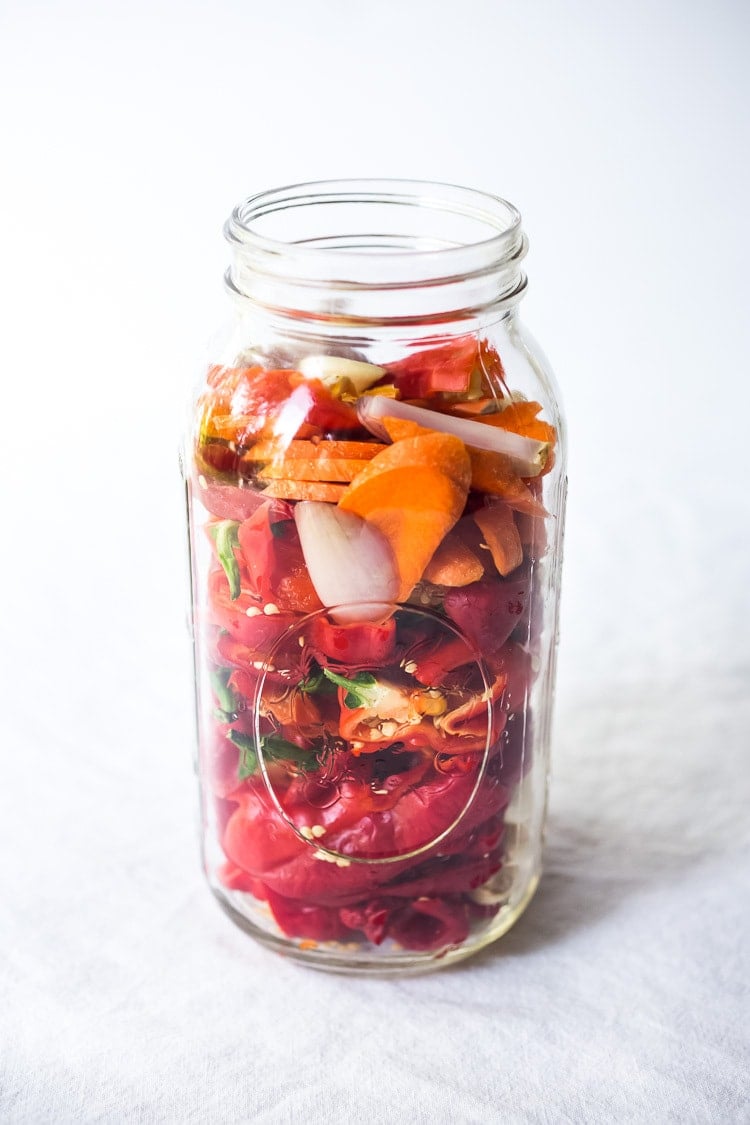
2. Make a saltwater brine. Combine 1 1/4 teaspoons fine sea salt per 1 cup of water.
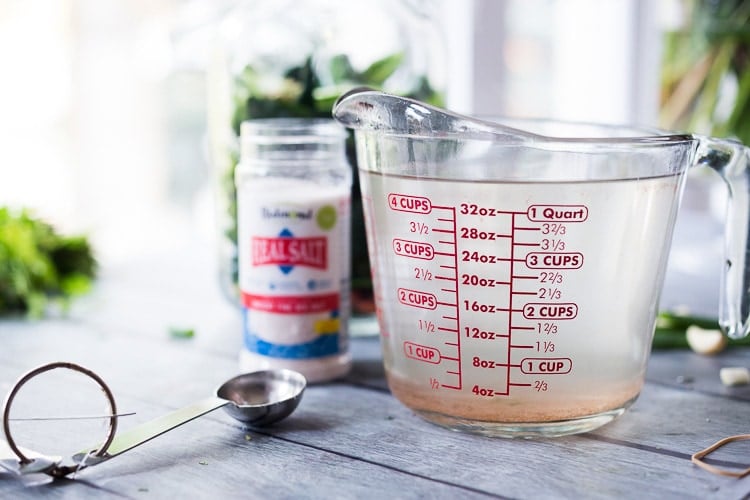
3. Combine. Pour the brine over the chilies and push them down so they are completely submerged. Feel free to cover the chilies with a cabbage leaf to keep everything down.
4. Weigh down the chilies. You can use a fermentation weight, like this version that I really like, that will fit perfectly into a mason jar, to keep everything submerged. If anything floats to the top, and touches air, this can potentially mold, so either fish it out with a slotted spoon, or push it down under the brine.
Tip: In a pinch, a zip-lock bag filled with water can be used as a weight. Place this over the top. I prefer using a glass or ceramic weight.
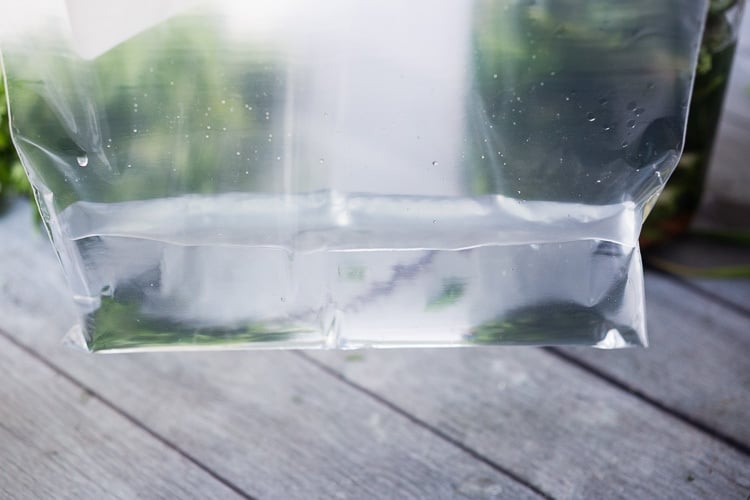
The water in the bag will work as the fermentation weight here. A small clean shot glass, placed over a cabbage leaf, can also act as a fermentation weight.
Here you can see I’m working on a mild green hot sauce which is still in the fermenting phase.
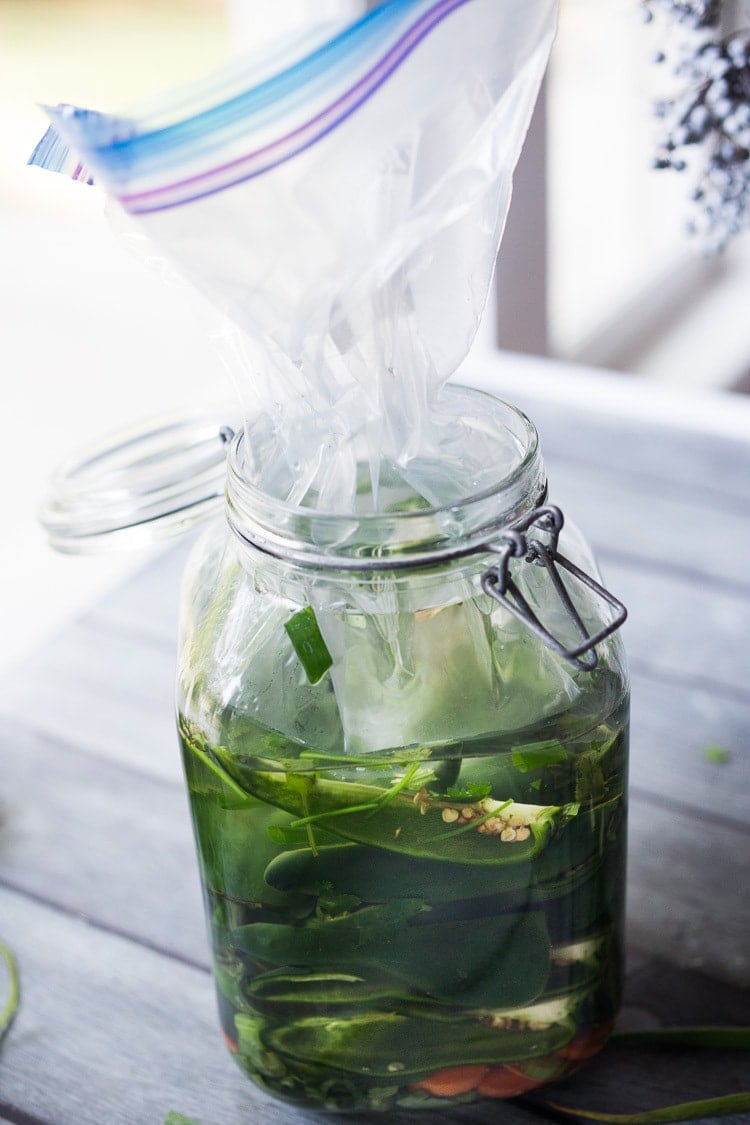
5. Place a lid on top. Place a lid on top, leaving it loose. You want the fermentation gases to be able to escape while keeping any creatures (bugs or flies) out. A couple of layers of cheesecloth also work here.
6. Store and ferment. Place the jar in a bowl or pan to catch any liquid that may spill over, and place it in a cool, dark place, like a basement-65F-70F is ideal. If you don’t have a basement or a cool place, a lower cupboard in the kitchen is an option.
Check every few days, removing any “floaters”. After a few days, the brine will turn slightly cloudy, and when you tap the jar, you should see little bubbles float to the surface or some overflow in the pan-all signs of life!
Ferment 5-10 days. I usually go 7-12 days, long enough to soften the carrots, which you will be blending in the sauce.
If, for some reason, you are going out of town, you can always place the ferment in your fridge, which will slow it down, but keep it alive, and you can resume when you get back.
Why is the Brine Cloudy?
Cloudy, tangy brine is a natural by-product of the fermentation process-a combination of lactic acid and yeast-and is the reason why they call it lacto-fermentation.
Various strains of bacteria are present on the surface of all plants, especially those growing close to the ground. Lactobacillus bacteria convert sugar into lactic acid, preserving the peppers.
Both salt and lactic acid prevent the growth of harmful bacteria. Over time, the cloudiness can settle out of the brine to the bottom of the jar. Some batches are naturally cloudier than others, but all are safe to consume.
A cloudy brine is a sign that you have a safe, successful, and tasty ferment.
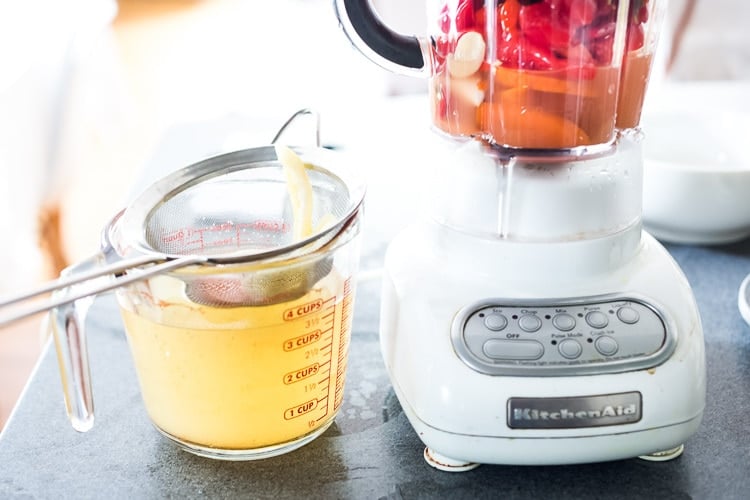
7. Blend! Strain the brine, saving it. Add the strained chilies/carrots/garlic to the blender with one cup of brine and blend until smooth, at least a minute! At this point, you can add herbs (oregano or cilantro is nice here) and spices (cumin, coriander, chipotle). Add a little splash of Bragg’s apple cider vinegar if you like (this is optional, but also full of healthy bacteria) and more brine to the desired consistency.
If you like the idea of sriracha, you could also make it sweet by adding sugar or honey, and perhaps ginger. You could also add herbs.
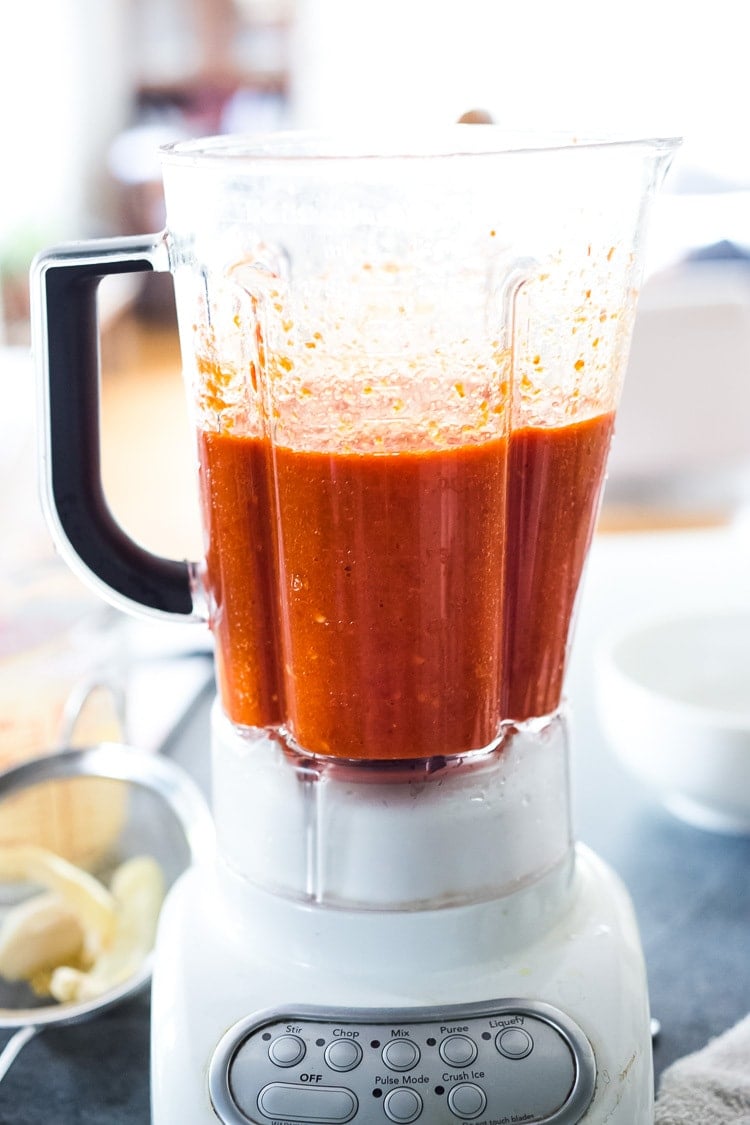
8. Store! For everyday use, store the fermented hot sauce in squeeze bottles, leaving the tip off or open (or lightly closed) in the fridge. The hot sauce will continue to ferment in the fridge, and the open tip will allow the gases out. Before using, cover the tip with your finger and give it a good shake.
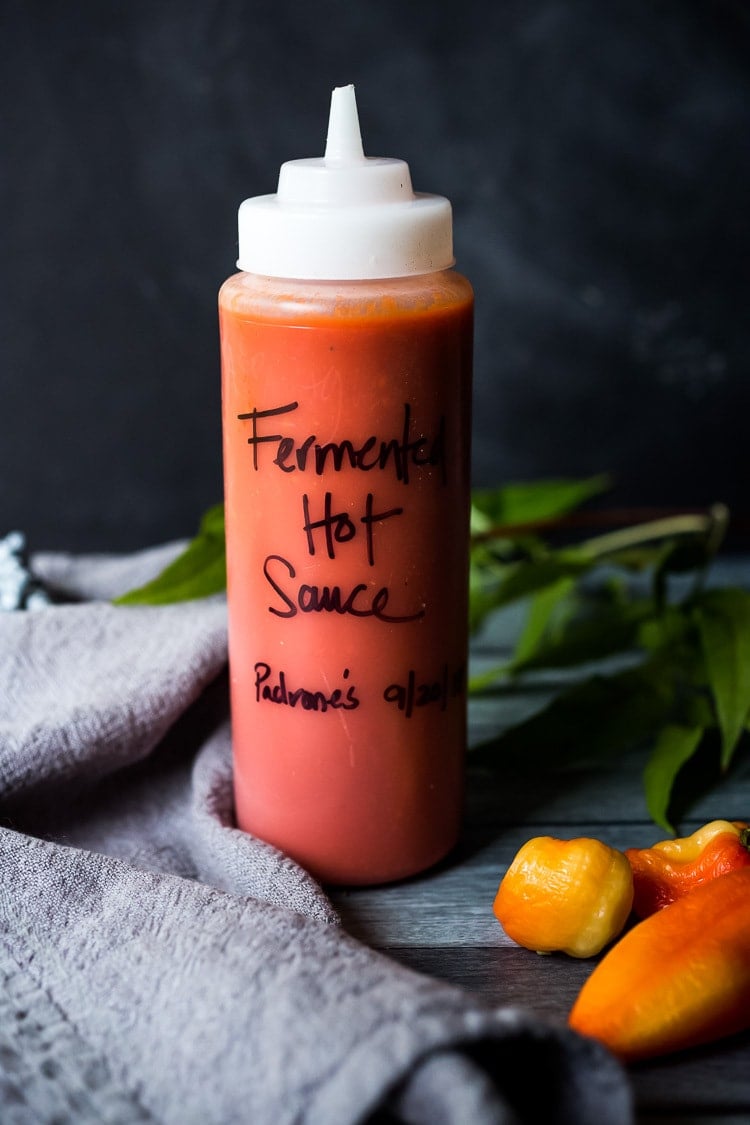
A little Warning!
If you place the fermented hot sauce in tightly sealed bottles, unrefrigerated, they will EXPLODE! This is because the hot sauce is still fermenting (producing gases) and will continue to create bubbles. Remember, it is alive, and this is NOT canning.
*If giving as a gift, yes, feel free to use a “cute bottle” but with instructions to refrigerate and loosen the lid.
But my hot sauce is way too hot!
Don’t be too alarmed if your hot sauce tastes overly hot when you first store it. After a week or two in the fridge, the gradual slow fermenting will substantially mellow out the heat! It’s quite surprising. Many times, I’ve made a hot sauce and tried it, thinking there was no way we would be able to eat it because of the heat level. But after a week or two, it really does calm down the heat. Fermenting the hot sauce gives it another layer of flavor, adding more and more complexity. This will keep indefinitely in the fridge.
Types of chilies to use
Use any fresh chili pepper you like or a blend of different peppers (in the same color palette). I prefer medium-hot red chili peppers like red jalapeno peppers or red padron peppers.
To temper the heat, feel free to add similarly colored bell peppers (red, yellow, or green bell peppers). For example, add a golden bell pepper to habaneros to temper the heat. Or, a green bell pepper to serrano chilies.
Keep in mind you will be blending the sauce, so stick with the same color palette to make a vibrant-colored sauce. For example, mixing red and green peppers will yield a brown hot sauce-not the prettiest, but up to you. 😉
Fermentation will mellow out some the heat of the peppers over time.
Helpful tools
- Fermentation Kit (optional)
- Fermentation weights
- 2-quart mason jar (8-cup mason jar)
- Blender
- Strainer
- Squeeze bottles
Making Fermented Hot sauce is a fun little project that only takes about 20 minutes of hands-on time-a lovely way to use up all the chilis in your garden (or a way to try out all the beautiful varieties at the farmers market), and a great way to bring more healthy probiotics into your life!
Mother Nature will do all the work for you! And after 5-7 days, you will end up with the most delicious, alive hot sauce that will get better and better with age!
Troubleshooting
- If there are no signs of fermentation, double-check that you measured the salt ratio correctly. This is typically the most common problem (adding too much salt will halt the process and kill all the bacteria, even the good ones).
- Try filtered water. Chlorinated water can halt fermentation.
- Do not over-wash or peel the peppers/carrots (for example, don’t use any type of produce soap), as the wild bacteria from the pepper skin and carrot peeling are what start the fermentation. I have the best luck with farmers’ market chili peppers and carrots because they are not over-cleaned or treated with anything.
- Mold: If your ferment has molded, something likely rose to the top of the jar and had contact with air. I would start over.
- Bad smell: The brine should smell tangy, garlicky, and fresh, not “foul” in any way! If it smells “off,” it could be that salt was mis-measured or the ferment was contaminated: dirty hands, dirty utensils, dirty jar.
Storage
Store the fermented hot sauce in squeeze bottles in the fridge. Leave the tip off, open, or lightly closed. It will continue to ferment in the refrigerator, and the open tip will allow the gases out. Fermented hot sauce will keep indefinitely in the fridge!
Serving Suggestions
This fermented hot sauce can be used on just about anything!
- In your favorite Mexican recipes: Mexican baked potatoes, tamales, vegan fajitas, tofu sofritas, green enchiladas, turkey enchiladas, chicken fajitas
- To elevate breakfast: breakfast burrito, chickpea scramble, baked eggs, vegan breakfast tacos, chilaquiles
- If sriracha-style, in Asian recipes: sticky glazed tofu bowl, miso salmon bowl, shrimp and broccoli stir fry, broccoli stir fry
FAQs
To make fermented hot sauce, the chilies and veggies are fermented in a salt brine for 5-12 days before being blended with seasonings to create a complex, flavorful sauce.
No, fermented hot sauce uses chilies and veggies that have been fermented, offering probiotic health benefits and a tangier, more complex flavor.
I recommend fermenting for 7-12 days to ensure the carrots and chilis are softened enough to blend.
Yes, fermented hot sauce will keep indefinitely, so long as it is stored in the fridge.
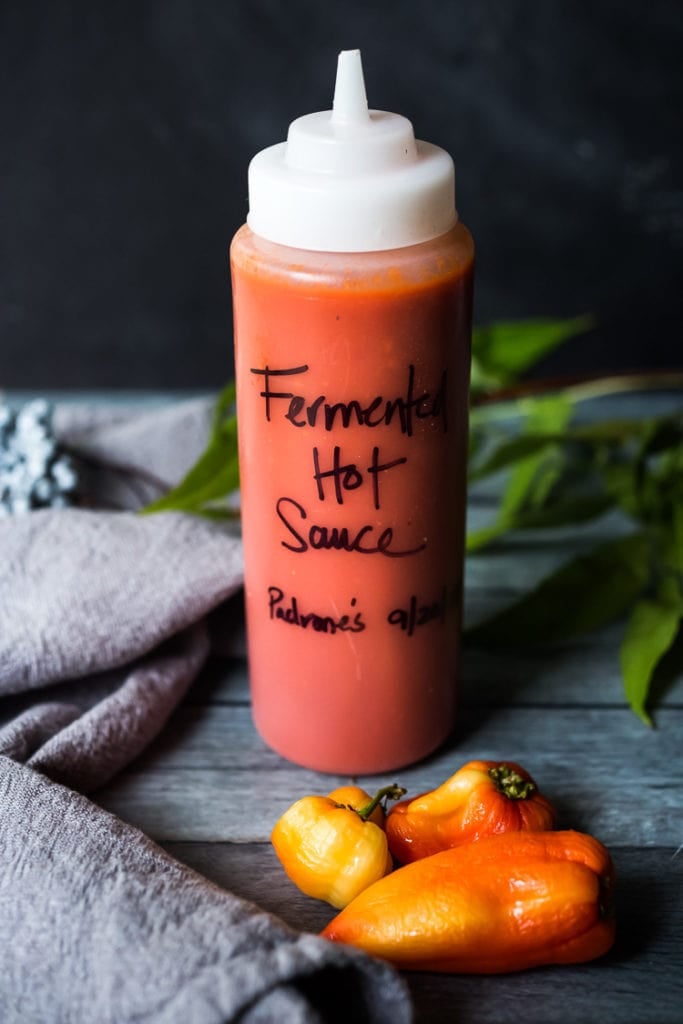
More Favorite Recipes!
More from Feasting At Home
Watch HoW to make Fermented Hot Sauce!
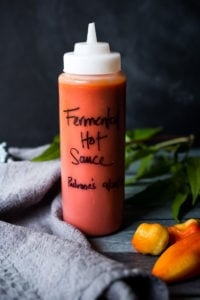
Fermented Hot Sauce
- Prep Time: 20 minutes
- Cook Time: 5 days
- Total Time: 120 hours 20 minutes
- Yield: 4 cups 1x
- Category: Sauces, fermenting, preserving
- Method: fermenting
- Cuisine: American
- Diet: Vegan
Description
A simple, delicious recipe for Fermented Hot Sauce using fresh summer chilies, with no special equipment and only 20 minutes of hands-on time!
Ingredients
- 5 cups filtered water
- 6 1/4 teaspoons finely ground sea salt (or Pink Himalayan salt) – use 1 1/4 teaspoon salt, per 1 cup of water.
- 2 Quart Mason Jar
- 16 ounces fresh chili peppers, sliced in half (about 6-7 cups) seeds & stem removed, see notes
- 1 carrot, very thinly sliced 1/16th-inch (do not peel!)
- 4–8 garlic cloves, cut into quarters
- 1–2 shallots, sliced (or 1/2 an onion)
- optional: herbs (oregano, cilantro, celery leaves) and spices (cumin, coriander, chipotle powder, smoked paprika)
- 1–3 tablespoons apple cider vinegar, (optional- for extra tang and for more healthy probiotics)
- honey or sugar to taste (optional, good if making Sriracha style)
- If your hot sauce is not hot enough, you can always add cayenne or ground chipotle to taste. Free free to add spices ( 1/2- 1 teaspoon) cumin, coriander, chipotle, allspice, etc. Make this your own.
Instructions
- Wash your hands, jar and ustensils. Not sterilized, just clean. 🙂
- Stir sea salt into the water until dissolved.
- Slice the small hot peppers in half, and remove stems and seeds if you like (for less heat). If your pepper are very hot, wear gloves. If adding bell peppers to temper the heat, cut into thin strips. Thinly slice the carrot (do not peel), slice the shallots, and slice the garlic.
- Layer all into a clean 2-quart mason jar. Top with a cabbage leaf to hold things down (optional) and pour the brine into the jar over the chilies, pressing them down under the liquid. If you need to add more brine, remember to use the ratio of 1 1/4 teaspoon salt per 1 cup of water.
- Weigh everything down with a fermentation weight (or use a small ziplock bag filled with water to weigh the veggies down or try a clean shot glass). You want the chilies completely submerged under the brine. Anything that touches air, may mold, so either spoon it out or push it down. Cover loosely with a lid ( or cheesecloth and rubber band) and place the jar in a pan or bowl to collect any liquid that may bubble over. The lid is loose here so gasses can escape easily, but no creatures can get in.)
- Place in a cool dark place, like the basement, 65-70F is ideal, (or the bottom cupboard in the kitchen) for 5-10 days or until signs of fermentation.
- On day 3-5: Check for fermentation: Tap the container and see if any tiny bubbles rise to the surface, check for a cloudy brine ( see notes) or check the bowl underneath, to see if there was any overflow. All signs of activity! Ferment 7-10 days, long enough to soften those carrots that you will be blending. And you can always ferment longer for even more flavor- I’ll often ferment 12 -14 days. Sometimes I’ll ferment 7 days, then place the jar in the fridge for a few weeks before blending. The longer the ferment, the tangier and more flavorful this will become, and the more mellow the heat. *If there are no signs of fermentation, give it a couple more days- then check the troubleshooting section in the post.
- After 7 days and signs of fermentation, strain and SAVE the brine. Place the fermented peppers, onions, garlic, and carrots into a blender and discard the cabbage leaf. Add 1 cup of the brine and blend until smooth as possible. This may take a couple of minutes. Add the vinegar if using, (and honey if you prefer a sweeter hot sauce like Sriracha), and more brine to desired thickness. At this point, you can blend in optional spices and herbs. ( 1/2-1 teaspoon spices, 1-2 tablespoons fresh herbs).
- Don’t be alarmed if it is overly spicy- the heat level will significantly mellow with time, as it continues to ferment in the fridge after 1-2 weeks. Place in a squeeze bottle and store in the fridge, leaving the tip open (or loose) for gasses to escape.
- Do not place in a sealed jar unrefrigerated– this will result in an explosion– and a great big mess- as the hot sauce is still alive and fermenting! BE WARNED! I have the best luck with using in squeeze bottles and leaving the cap off in the fridge.
- If transporting to a friend as a gift, it is ok to seal for short periods of time (a few hours) but make sure to tell them to refrigerate it and loosen the lid, very soon after receiving.
- The flavors will continue to develop and get more complex over time, the heat mellowing.
- To use, cover the tip of the opening with your finger and give a shake before using.
- This will keep up to 12 months in the fridge (probably even longer!).
Notes
WATER: Regular tap water may contain too much chlorine in it, inhibiting the fermentation process (although our tap water works fine). If fermentation is not happening, you may want to try filtered water.
SALT: I use fine ground sea salt or Pink Himalayan salt . If using coarse ground salt you may need to add a pinch more.
Peppers: Use any chili pepper you like or a blend of different peppers (in the same color palate). To temper, the heat, feel free to add similar colored bell pepper -substitute sweet red, yellow, or green bell pepper. Keep in mind, you will be blending the sauce, so stick with the same color scheme to make a vibrant colored sauce. For example, mixing red and green peppers will result in a brown hot sauce– but up to you. 😉 Also, keep in mind, the fermentation will mellow the heat a little. Removing the seeds will help temper the heat.
RATIO: If you need more water to cover or fill the jar, use 1 1/4 teaspoon salt per cup of warm water.
You could easily halve this recipe or use two, quart-sized jars.
CLOUDY BRINE: A cloudy brine is a natural by-product of the fermentation process-a combination of lactic acid and yeast and is the reason why they call it Lacto-fermentation. It is a sign of fermentation. Various strains of bacteria are present on the surface of all plants, especially ones growing close to the ground. Lactobacillus bacteria convert sugar into lactic acid, preserving the peppers.Lactic acid prevents the growth of harmful bacteria. Over time the cloudiness can settle out of the brine to the bottom of the jar. Some batches are naturally cloudier than others, but all are safe to consume and taste delicious. A cloudy brine is a sign that you have a safe and successful ferment.
Signs of fermentation: liquid overflowing into the bowl (check the bowl to see if the jar overflowed, a good sign! Tiny bubbles rising to the top when you tap the jar. Cloudy brine, tangy flavor or smell.
Nutrition
- Serving Size: 1 tablespoon
- Calories: 4
- Sugar: 0.4 g
- Sodium: 112.3 mg
- Fat: 0 g
- Saturated Fat: 0 g
- Carbohydrates: 0.9 g
- Fiber: 0.2 g
- Protein: 0.1 g
- Cholesterol: 0 mg
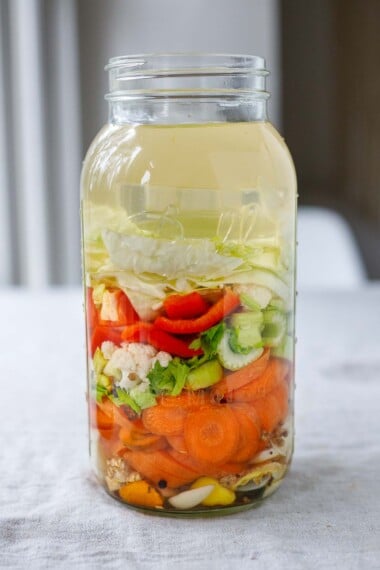
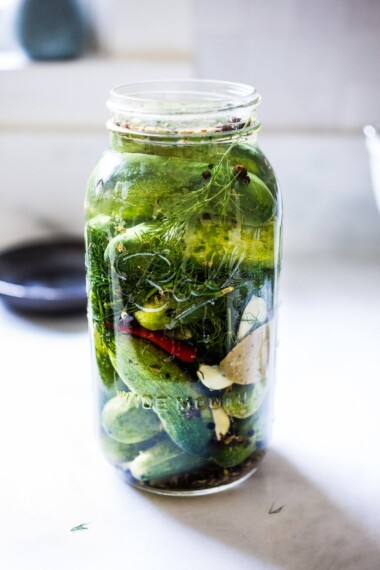
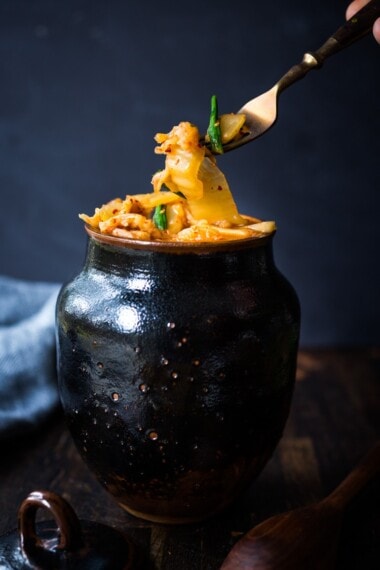
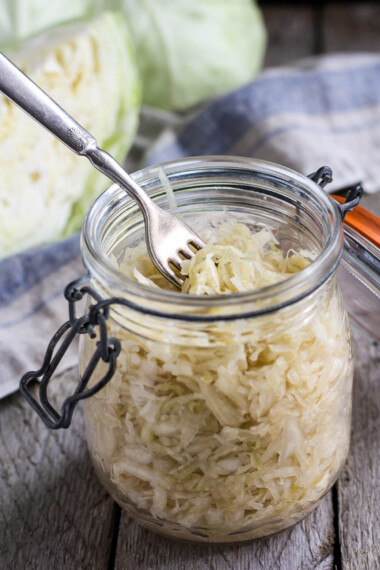
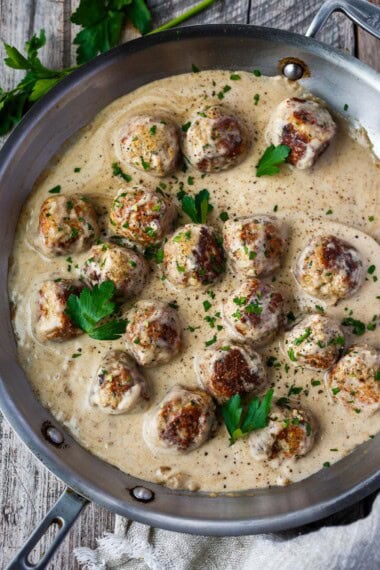
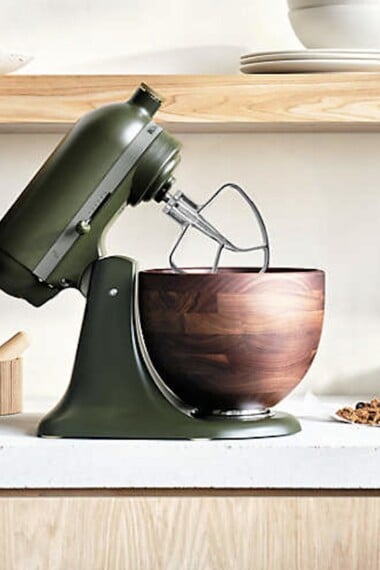
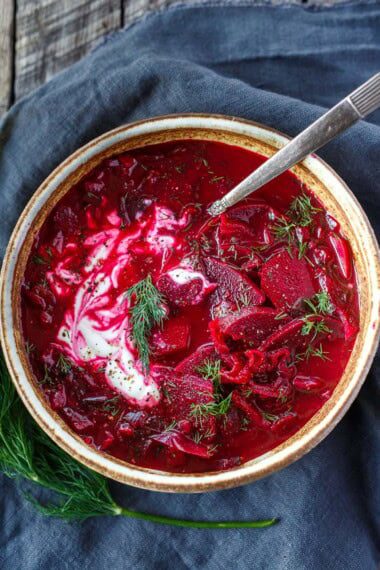

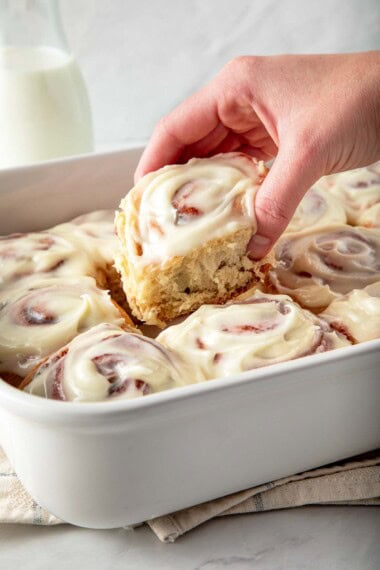

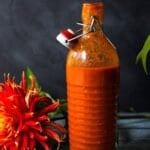
I’m not sure my fermenting worked…it isn’t particularly cloudy and I don’t see any bubbles. It’s been fermenting for almost 2 weeks and I made sure to use the correct salt ratio. Any thoughts? How can I tell for sure that the fermenting worked? Or should I just toss if any doubt?
Hummm, that is strange! When you tap the jar,(or stir it) do any little bubbles rise to the top? Do you see any mold? Where did you keep the jar? Just trying to pick your brain for clues! 🙂
Works really well. I strained it in a colander to get rid of the little pieces of peel so it is a smooth puree.
The best ever fermented chili sauce
Just finished four jars. I have a few questions: will it mold? When and how will you know if it’s gone bad and not safe eat?
This process really drew in the fruit flys while covered on the counter and smelled up my house when processing. I made three levels of heat, mild/medium, medium and very hot. Saving some for Christmas when I will have a group of hot sauce lovers in house. I hope it keeps that long.
Hi Chan, the salt will prevent molding and bad bacteria growth. Refrigerate after the fermentation stage (after blending) and it will keep indefinitely.
Just processed my last batch of habanero sauce. I seasoned with Penzy’s Arizona Dreaming seasoning and red wine vinegar this time.
It tastes great! Do try this.
Glad you like it!!
Nice little recipe! I’ll have to try this with all the jalapenos my garden has grown.
Can you use dried peppers instead?
You want to use fresh peppers for the fermentation to work!
Do you have to use garden fresh peppers? Or can I use store bought?
Garden or farmers market are best, but in a pinch store bought will work too!
Looks easy and delicious
I’m excited about this recipe. Can you really leave the stems on the peppers and just blend them in? I just made a batch with serranos from my garden, and they just seemed to woody, so I just them off. But maybe I should have trusted you and saved myself the effort?
Hummm….you are right…better take them off. Mine were just thin little stems about ¼ inch long.
I tried this method for fermenting. During the first few days, does it cause a stinky (sorta rotten onion) smell? Maybe I did something wrong. I loosened the lid a little to let the gases escape, but had the bag with water covering my peppers.
Nope- nothing wrong- I think they are probably fine!
Thank you Sylvia!!!!
This is my first time doing a fermented hot sauce. I was a little leery about it at first, but it turned out well.
I just completed a quart of cayenne and a quart of habanero. I used the bag of water method for keeping them submerged and lightly tightened rings and lids in canning jars. I only added garlic and onions for the ferment, and post ferment blended in red wine vinegar and thyme to taste. I fermented for 10 days. The ferment adds a funkiness that I can’t quite explain. Maybe a pickled olive like taste? It’s very tasty though.
It’s good enough that i’m starting another batch of habaneros tonight. I’ve made a bunch of cooked hot sauces in the past, but this one is really growing on me. Go ahead and give it a try!
This is a great recipe ….. I’ve used a similar one in the past with good results. My questions are: (1) does adding vinegar after the fermentation kill off the good bacteria, and (2) what percent salt is your brine formulation? I’ve seen a few recipes and they are all a bit subjective on the salt portion of the recipe.
I think this is a 3% brine ( 30 g salt per L water -or 1 oz salt per qt) I don’t think the vinegar kills the fermentation, but truthfully I’m don’t know for sure and I think that is a good question. I will do some research.
The hot sauce appears to continue fermenting in the fridge with the vinegar added.
Hello Sylvia,
Thanks for answering my previous question about the carrots! I have one more question: can I reuse the brine from the last batch to ferment more peppers?
Thanks,
Nikko
So I’ve heard that you can, but it didn’t actually work well for me? Not sure why.
Not sure if you added more salt when you tried to reuse the brine, but I heard that the vegetable soak up a lot of salt. So perhaps adding more salt will be the trick. I will test and get back to you.
All the best,
Nikko
Question: If I plan on bottling the sauce after fermentation, do I boil it to stop the fermentation first?
There is really no point of fermenting this if you are bottling. It will kill all the good stuff happening in there.
Hello Sylvia,
Thanks for sharing this recipe! I didn’t have any carrots so I carried on without. Is there any reason why you add carrots? Like, will my face fall off if eat this hot sauce without carrots?
All the best,
Nikko
Hi Nikko! It just depends on how hot your chilies are! 🙂 You don’t need the carrots, but they add a little depth and sweetness. But not imperative.
About to try fermenting for the first time with your recipe. I have a bumper crop of hot banana peppers from the garden.
I have a question! I’m doubling the recipe, I had 2 lbs of peppers. Do I need to leave it a little longer, or should I just look for the same signs as in the original recipe?
I think just look for the same signs! Some bubbling when you tap the jar and some cloudiness.
so exciting!
I managed to forget about them, despite all the effort I put into making them, so they sat two weeks. They’re perfect! The sauce is a nice light yellow and WICKED hot, but with a complex flavour. Thanks for this!
Sounds wonderful!!! Thanks for sharing Sandi!
Great recipe, made a batch with fresh Hatch green chili’s. Hotter than I expected. You said to save the brine, can you use it again?
WEAR GLOVES FOR THE LOVE OF CHILIS! Also what do you use the surplus brine for?
Would you suggest for HP person fermented veggies. I personally cannot tolerate any salt, as my pressure rises.
Talk with your doctor. There is quite a bit of salt in fermented things…may not be best for you?
Hi! Very much appreciate your recipe. I have been doing something similar w/ cayenne peppers for a couple of years now. I like mostly cayenne, a few jalapenos, a few habeneros and then garlic. The difference in my method is after fermentation I bring the brine and all to a boil and simmer for a few minutes before blending and canning. I am curious as to the difference and why you might do one and not the other. Can’t say I have a real reason I have done this other than the first recipe I followed did this. Do you have any thoughts on cooking vs not cooking after fermentation? Is there a difference in taste or perhaps shelf life? Thank you!
Hi Alex, great question. This is fermented, not “canned”. Canning (or the boiling before) kills all the fermentation or the healthy bacteria. It is just a different product in the end. Canning is great for long time unrefrigerated storage. But canned goods will not have any living, healthy probiotics in it. Here the peppers are fermented, and because it is refrigerated, not cooked or boiled all the good healthy bacteria, stay alive. Very good for gut health. Hope that helps. Two totally different ways of preserving.
Sylvia, what a wonderful recipe! Thank you for sharing. You solved my problem of growing too many hot peppers. The sauce is delicious and so is the brine. How long has your sauce lasted in the fridge now?
I’ve had some for a year now! Still good! It just keeps living. 😉
Sylvia, thank you for sharing this recipe! I had too many hot peppers in my garden and this worked out perfectly. The hot sauce is delicious! And so is the brine. How long has yours lasted in the fridge so far?
I missed the note not to use tap water. Should I just keep an eye on the cloudiness and bubbles to make sure it ferments?
It probably will be ok. I’ve used tap water and it has been fine. Some people’s tap has more chlorine which hinders fermentation. So to be safe I just said that.
I’m sorry I saw someone post down below, but is it really teaspoons and not tablespoons? Other recipes I’ve seen you a lot more salt.
I know…but this works. 1 teaspoon salt per cup of water.
Thank you for such easy-to-follow instructions. I just bottled my first batch made with long yellow cayennes. It is lovely. . .
So glad you like it Randy!